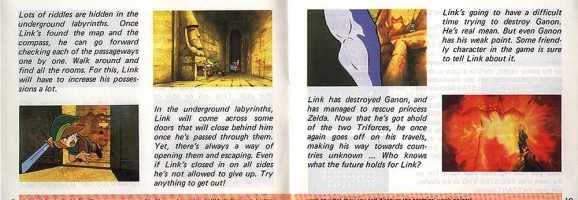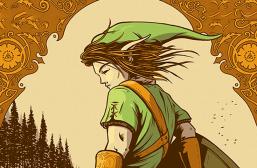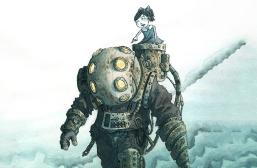The Lost Art of the Video Game Instruction Manual

Most contemporary video games do not come with instruction manuals, opting to forego printing the booklets. 3DS games, for instance, have digital manuals installed that can be accessed during gameplay. A number of PS3, Xbox 360, and Wii U games do this as well. Many games are digitally downloaded anyway, and players never even have any physical traces that the game exists. Video games have become more ephemeral over the past two game generations, with the rise in popularity of digital downloads on consoles, PC, and handhelds. This is evident particularly in the lack of instruction manuals, which were once a source of both information and wonder.
Open any NES (short for Nintendo Entertainment System, Nintendo’s 8-bit console, first released in 1983, essentially revolutionizing the home console market) game instruction manual and there will be pages of epic or humorous storytelling, details and descriptions of protagonists and antagonists, and even the lower quality manuals (ones not from a major publisher) have a wealth of interesting information. Combined with the stories are original and in-game art, pumping players to play through the game, see the sights.
One of the greatest NES game manuals (and one of the greatest NES games in general) is the one that came packaged with the original The Legend of Zelda (1986), with its shining gilded cover and plethora of stories, hints, original, hand drawn artwork, and even a map of the beginning of the game.
“A long, long time ago, the World was in an age of Chaos,” the manual begins ominously, setting the tone for players’ adventures in Hyrule. What follows is an in-depth recount of Hyrule’s history, the major characters, the story of Ganon, the antagonist, something that could have been included in the actual game via text (this was long before lengthy cutscenes and even before much text were regular features in a game). But there is a certain magic in holding the instruction manual, that thin little booklet, and scouring over the tale, as if reading some ancient document. More than just relaying information to the player, the instruction booklet serves to intensify the quest and immerse the player more into the game’s world and plot.
Game developers communicate very differently with their players in contemporary gaming, where on average, a game will begin with at least a few minutes worth of cutscenes, dialogue, and world building. Due to increasingly progressive technology, games such as Final Fantasy XIII (which actually did come with a well-written instruction manual, albeit without anything the game does not already convey to players) can have cinema-quality cutscenes that last longer than ten minutes, with exquisite, action-packed visuals and voice acting. The instruction manual for Final Fantasy XIII introduces both the game world and its protagonists, but there is no need to resort to the manual as the game gives a better, and certainly more eye-popping, introduction. In this way, game manuals are obsolete.

There is also the matter of gameplay help and tips, the reason for the instruction manuals in the first place. The Legend of Zelda‘s manual has over thirty pages of information concerning item use and combat, and even a long list of hints leading players to the more obscure secrets in the game. Contemporary games, with various results, teach players how to play in-game, and usually give the player an initial trial to master its systems. Games such as the excellent Dark Souls integrate learning the game’s controls and systems into the gameplay very naturally, where players do not have to sit through long explanations. “Hand-holding” refers to the act of games being too linear and obvious with their learning curve, often forcing players to stop playing and listen to what the game has to say. “Hand-holding” is an entirely modern concept in games, as instruction manuals never force information down players’ throats and only offer mild suggestions. The instruction manuals allow games to get right into the action, allowing players to resort to them only when necessary. Contemporary games also have increasingly complicated systems (compare The Legend of Zelda to Skyward Sword, with its complicated sword combat) and sometimes require directions that cannot be explained well with just text, though.
Sites like GameFAQs and the collective consciousness known as the internet in general allow players to collaborate and find a game’s secrets without help from the publishers. The Legend of Zelda‘s manual hints at checking under certain trees to find secret passageways, whereas if the game was released today, players would quickly find all the game’s secrets and post them on a message board. This isn’t to say that some of the magic and mystery is gone from finding secrets in games, as there is a certain charm in working together on a message board or looking up tips on Youtube. But the dusty relic that is a game manual was an important part of the gaming experience for nearly a decade, and it is a shame to see it fall into obscurity.
One of gaming’s most infamous instruction manuals, the booklet for StarTropics (1990), an action-adventure game for the NES, features one of the most engaging and striking uses of meta in a video game (meta refers to something outside of the actual game). Attached to the game’s manual was a yellowed piece of paper, supposedly resembling parchment, that held a secret code within its fibers that could only be seen when some water was rubbed over the paper. During the quest, protagonist Mike Jones is told to “dip [the] letter in water,” and players are tasked with figuring out what this means.

The act of playing through the game and figuring out the mystery is quite the experience, and nothing quite like it has ever been done since. Since most players bought the game used, without a manual, the code was constantly published in Nintendo Power, but for those that solved the puzzle firsthand, it remains a great moment in gaming. The Virtual Console release of the game includes the letter in with the digital manual, and at the bottom of the screen is a small pail of water, which is Nintendo’s way of trying to be true to the material.
The meta aspect of the instruction manual cannot be overstated, as the manual serves to immerse players in the game which they have purchased, however, there are a handful of contemporary alternatives that should be mentioned. Stephen Murphy, the popular indie game maker known as thecatamites, often includes extra notes in his digital downloaded games. In his sinister Lake of Roaches, which centers around a surreal fishing trip, among the files in the folder, is a small text document which reminds players to email him for “good fishing tips.” Small details like these enhance the game’s presentation and its tone and atmosphere. With digital downloads on the PC, game developers can include whatever they want and they should be encouraged to do so. Small notes or illustrations are always nice.
There is also the matter of special edition copies of games, which typically include an art book (of varying quality), a soundtrack, and sometimes a figurine or other collectible. These editions are priced higher than their non-limited edition brothers, but add to the absorption and involvement. Many large game releases have a special edition, including Dark Souls II, Borderlands 2, and Grand Theft Auto V, and even less popular ones, like Arc the Lad Collection, have a wealth of extras.
So, the question: should players even care that manuals are going the way of MySpace, Razor Scooters, and HitClips? As far as utility goes, they’ve become obsolete. For those players who want the extra art and lore, there are numerous alternatives. And some games, like Grand Theft Auto V, which featured a lengthy manual as a free app download, have absolutely wonderful digital manuals.
The simple answer is no, there isn’t really a need for publishers to print out these manuals that no one will read. Even in the days of the NES, most manuals sat in a box, collecting dust, or were simply thrown out. Most used NES games do not come with manuals or boxes, as many players simply did not care about them.
But it’s more complicated than that. It’s nice to open a game case and see more than just a product registration insert. It seems to speak volumes about the game industry, how video games are much less personal than they used to be, that the quality of the gamer’s experience is less of a focus.
The truth is, though, that Pokémon X, released in 2013, comes with more than just a registration insert. Behind the Club Nintendo offer, there is a notice for players to download a special Torchic to use in the game. The package could have used a poster, but the special Pokémon is nice and shows Nintendo cares to make a decent product. Publishers and developers should be encouraged to make these small editions to a game’s overall, physical presentation, and many of them already actively seek to give buyers a bonus.
Now, it could be argued that these extras, a Torchic here, a special Event Pokémon there, even collectible figurines, are great, but do not make up for the lack of the physicality and immersive qualities of the instruction manual. The instruction manual should be an assumed piece to the game experience and should not just disappear. With the advent of the plastic cases (before the PS1, games came in cardboard that was easily beat up) that games come in, the instruction manual can easily be stored and preserved. Instruction manuals will remain a charming addition to game history, regardless of what their future holds.
What do you think? Leave a comment.











Jumping straight in and trying to figure it out for yourself works for some people, but not for everyone.
A lot of people don’t have the time, so they want someone or something to guide them. It’s the same reason we like other mediated information in news and education.
There will always be a need to explain technical “stuff” to a non-technical audience. Look on YouTube and you’ll see clips of films from the 1920 and 30s showing people how use a rotary telephone. There’s a huge industry in creating missing manuals , “For dummies” books, which are effectively independently created instruction manuals.
Manuals come in all shape and sizes. Some explain Why you should do something, some explain What to, and some (most, in fact) explain How to do something.
There is a lot of debate in the technical authoring community about whether there are better ways to provide user assistance beyond the traditional manual, and I’m sure we’ll see new deliverables emerge.
I think it’s the same with physical manuals for anything. Apple computers don’t come with manuals because ideally the system would be intuitive, and the designer reasonably assumes a digital manual would have the superior interface. If this trend were intentional, I’d say that a lack of a manual would challenge a game designer to make the game an enjoyable experience of both playing and learning, but every game is imperfect, and the humble game manual appears to be the victim of fashion rather than progress
You’re very much correct, but the manual for an Apple computer does not need to introduce lore or display art or anything like that. Video game instruction manuals are more than just instructions – they’re story books and art books.
Manuals are for noobs and old people.
The best way to learn about anything, software, hardware or whatever is to jump straight in and try and figure it out for yourself. This usually involves breaking it at least once along the way (esp. software like operating systems), but learning how to fix it only adds to your knowledge and appreciation of the product.
All a manual does is tell you how to do something, it doesn’t teach you to understand how or why you’ve done it.
But the thing is, a video game instruction manual is way more than just providing info on how to do something. It’s, at its best, is an extension of the game’s world into the player’s physical environment.
Thank god most game manuals can easily and quickly be searched for over the internet. Arts at its finest.
I’ve continually argued that I love and miss game manuals… and that even the digital ones don’t make the cut. I still have the beautiful hardcover manual that came with my special edition copy of Lunar 2: Eternal Blue.
Great read!
The Lunar 2 one is great! Working Designs was one of my favorite publishers back then. They did Arc the Lad Collection, too.
Too true. Indeed a lost art. You see the instruction manuals of old were more then just “this is how you play” the game. In many ways it was a sort of an introductory book, a short novel, to welcome you into the wondrous world you were about to take part in and honestly, for a few moments, become a part of.
The last video game manual I ever read (or as good as the ones of old) was for Metroid Prime for the GameCube. Man was is great. Metroid Prime would be my first Metroid game and I have no regrets.
In all honesty. I skipped most if not all of the instruction stuff on how to play. It was the story, the character bios and lore that I read. Some where was I would even go far as to say were like comic books (some literally were) and acted as visual novels.
Ultimately, while it is indeed a lost art form, most other ways on getting the information on a game and its story/back-story has evolved with the times. All of the instruction in how to play the game are now done through in-game tutorials (much to some of our annoyance, especially un-skipable ones). While we have lost out in this old art, I feel it would be best to embrace the new potential and opportunity for game designers and writers to tell us the great aspects of their game and its world and characters in-game as technology now allows, but is not always done, which is a shame. I would like to see more games done for the story as well as awesome game play; those are the ones that stay with us the most.
Even though I’m not an avid video game player, I agree that having an instruction manual can be part of the gaming experience. I think the older crowds can appreciate the gimmicks and the accompanying fond memories, while the younger crowds (especially first-timers) would love the personalized spectacle. I feel like they could make it an option in the ordering process, i.e. “Would you like an instruction manual included? If not, digital manual is included in the game.”
Really, it seems like the biggest problem is the stigma that the words “instruction manual” have gained. As most manuals are going digital, what if game developers started including a graphic novel of the lore with a “glossary” of the technical details? I think people might be less likely to toss it aside, if they knew it was a graphic novel of the game, rather than a bunch of technical details they would skim over.
One of the reasons people don’t read manuals is because it’s generally pretty easy to figure out the basic functions with the ingame tutorials and all.
A consequence of this, however, is that very few people use more than an often smaller subset of the games’ available “functionality”.
I regret throwing away my NES manuals, they had no value when I bought them back in the 80’s/90’s…
As someone who grew up playing JRPGs such as Final Fantasy and Kingdom Hearts, the growing lack of manuals is actually somewhat disheartening; it’s as if a part of my childhood is leaving along with the physical manuals.
I admit, I never thought much of them before, and I never really collected said manuals. As a child though, I enjoyed flipping through them in my spare time. The artwork was always memorable in games such as the earlier Final Fantasies; the artwork by Yoshitaka Amano seemed so much like a fairy tale. Then I started playing the later Final Fantasies and Kingdom Hearts, where art was helmed by mainly Tetsuya Nomura. His style reminded me much more of contemporary manga and anime, which I also consume and appreciate.
These days, I realize how much I miss having something as simple as an included manual. I miss the art, the beginner’s tips, even the character bios. True, some modern games do include a digital manual, but it’s simply not the same as having a physical copy to thumb through and go back to over the years.
I have fond memories of ripping open the packaging of a brand new game and looking at the materials within. I felt like before I began to play, I wanted to at least briefly view the manual’s contents—not really for the how-to portion but for the introduction, the images and the story they might allude to. I’d even enjoy looking on the art of the game disc, as well as some art that was often sitting underneath where the disc sits in its case. My brother on the other hand would be too busy jumping right into the game, even though I wanted to savor the moment (our parents didn’t buy games for us very often, so it was always exciting).
It’s a shame that these manuals have become outdated. Obviously there are more benefits to being able to access manuals online at the touch of a button; information, artwork and tips are easy to obtain now compared to a simple booklet that once came free with games.
I remember when even a game like Pac-Man would have an instruction manual with some kind of backstory. Now I feel like all of the world-building comes from the game itself– like you said with cutscenes and other methods. It would be nice to see more games with physical manuals.
With the advent of games like Dear Esther and Heavy Rain, it’s interesting to see the meta-engagement coming back in-game. Games like Eternal Darkness: Sanity’s Requiem did it differently, but there’s a distinct lack of self-awareness of the medium of video games since the manual disappeared. I’d be interested to see the manual for TBAs like Zork — anybody have one?
You could probably find a PDF of it online.
Interesting article, and certainly a part of gaming that has been discreetly fading away. Some people might have already said this before, so sorry if this comment is just a reiteration of previous comments. The manual has certainly been a veteran part of gaming. As you state, manuals have been the source for the backdrop and tutorial for games. Nintendo has been particularly successful in utilizing manuals as a medium for plunging gamers into the world that the developers have created. The original Super Mario and Legend of Zelda are great examples of manuals that fulfill that purpose. Also, as you’ve said, the setting portion of manuals is now mostly obsolete. Why convey to the reading the setting of the game in limited text when you can engage them instead with gameplay or cutscenes? Games are, after all, primarily an interactive experience, so it doesn’t make sense to detract from the interaction. Manuals were created because of limitations of memory, a major problem early games faced. Just look at Metroid and their super long passcode saves. There was no room for a tutorial or early cutscene, not to mention when manuals were first introduced, the concept of an in-depth tutorial was foreign and unrealistic.
I’m confused about your sorrow for the disappearance of instruction manuals in games. You’ve acknowledged most contemporary equivalents and other mediums which clearly outclass manuals by far both in form and function. As you’ve pointed out with Lake of Roaches, an outside means of giving information does not need to come in the form of a sheet of paper stuffed inside of a game case. Nor does a physical manual indicate anything about the game company’s dedication towards players. Toiling to create a quality tutorial or cutscene shows much more dedication than a pack of papers that can be written effortlessly.
In the end, game manuals are a thing of the past. Some gamers will look on them fondly because they represent a physical connection to the game. Others will breathe a sigh of relief that we are finally past the stage of reading to absorb all the information of the game mechanics and plot. Just like rotary phones, they are a thing of the past.
I do miss instruction manuals. I’ve got a little collection of some manuals from my favorite old NES and SNES games.
I remember the first computer game manual I got was that of Tomb Raider 2. Indeed it added something to the game itself, maybe because holding a handbook in one’s hand would give the sense of reading a scroll among those ruins.
I really miss the days of looking at a game manual on the ride home because I couldn’t wait.
Being a PC exclusive gamer, I haven’t seen a manual in years. Anything I want to play is handled through Steam or EA’s knockoff, Origin. There really isn’t going to be much of a reason for packaging in the not too distant future as well. But lo, do I remember the video game manuals of yore. I still keep a couple of boxes of classic and fondly remembered games, and I still have my manual for Baldur’s Gate II. A veritable book detailing every aspect of the game. Using this example, Baldur’s Gate and Baldur’s Gate II were based off the old 2nd Edition DnD rule set, which wasn’t directly intuitive, so the manual itself had to be detailed. We’ve streamlined the process so much at this point that you can still have depth without the requirement of a small novel on your hands. A tutorial level that sets up the main plot solves a lot of problems at once, familiarizing the player with controls and setup while setting the stage for the story.
Baldur’s Gate II is a great example (and a great game)…
I miss the instruction manuals so much! I remember The Sims’ original manuals – they were funny, quirky, silly, all in all a fun read. And the best one I’ve ever read was the Earthbound User Manual, which I reread every year or two just for fun and nostalgia’s sake.
Also notable is the incredible literature that is the EarthBound strategy guide… < 3
I, too, miss the days of the instruction manuals, but I understand why they have disappeared. (Also, the more recent ones seem to lack much of the charm of the old ones anyway.) My favorites were the old NES ones that featured artwork that barely resembled the in-game pixels. As you and others have pointed out already, this is part of their “art.” In times when game designers might have felt limited by 8-bit graphics, artists would use the canvas of the instruction manual to communicate more fully the visual ideas. And without a lot of space for story, the game manual could provide plenty of background and character descriptions to give the game an otherwise absent narrative power. Whenever I’m hunting down games from the 80s or 90s on eBay or Amazon, I’m always careful to make sure the manual is included. If not, I’ll look elsewhere. The old games feel incomplete without them.
Interestingly enough, many game developers today find that 3D graphics are limiting and instead choose to express their worlds via 8-bit inspired graphics. Obviously time, money, and skill come into play here, but there’s a bit of irony here nonetheless.
I’m enjoying your comments, by the way.
I miss the instruction manual. I always loved reading the character information and having the quick reference guide to read. They were their own unique form of literature at one time!
I found this to be a charming argument for the printed instruction manual, but all in all, majority of gamers enjoy just going into the game knowing nothing. I can’t explain why, they just do. I tend to do that as well. It’s some type of thrill that one gets enjoyment from. The instruction manual will be missed, I always enjoyed scanning the artwork in them. RIP Instruction Manual
Oh the instruction manual.. The good old days of looking up a character from Super Smash Bros. Melee’s moves in the manual.. Not even that it was needed, but it just felt it was “part” of the game.
I do really miss them. Opening up a game and flipping through the manual really did feel ‘part’ of the game as David said. It doesn’t feel personal anymore, and I for one can’t stand the random registration pamphlets we get nowadays.
When I was growing up, the manuals had all the secrets and the answers. It was like an unboxing of the game. It’s the first time you see the characters and get a sense of the adventure ahead before you put the game in the system. I haven’t noticed the decrease in game manuals until I read this and it’s unfortunately very true. But super thought provoking as well. Nice job~
To this day, the first thing I do when buying a new game is open the manual. But, as you said, the past decade has been less willing to accommodate my desire to see character profiles and read a blurb on the history of the game world.
I would love to see someone compile a coffee table book on great game manuals!
This is a really thorough article. I think one of the main causes for the decline of the user manual is the transition from linear to non-linear narratives, which I guess would be due to the rise of the sandbox form. Increasing the number of variables, and pathways through the game, mean a coherent manual becomes more and more difficult to write.
“Immersion,” is absolutely the key word. Nintendo’s manuals were legendary when I was a kid. I still have Poke’Mon Yellow’s manual under my bed, with pages falling out. The staples are probably eating through the acid-filled paper, but there’s nothing I can do about that now. Swear to God I will never forget those very first hand-drawn images of the original 150. My nostalgia is leaking. ;-;
Thank you so much for writing this article!
Great article! I’ve also explored this phenomenon from a technical writing perspective. These instruction booklets are nostalgic to say the least but they’ve just become obsolete like so many other paper based objects in this digital age.
I can certainly understand why people lament the disappearance of instruction manuals – I used to enjoy them, too. And though part of me agree’s with the assertion that they are simply extraneous now – since games are able to communicate much more deeply and effectively – there are certain aspects of them that could STILL have a useful function.
The control layout, for instance, was something I referred to in a lot of manuals. What botton does what? This information can be found in menu’s in modern games – but it was easier to just flip the book open to page 3.
The notes section in many manuals was also helpful. That’s where I would put my own personal techniques or cheat-codes (which were spread mainly by word-of-mouth back then) Now we have forums I suppose, but I remain wary of digital things.
I fear there will come a time when the internet is destroyed and the only video games left will be Nintendo cartridges.
“I fear there will come a time when the internet is destroyed and the only video games left will be Nintendo cartridges.” That seems pretty cool to me ; )
The death of the instruction manual (much to my dismay) has a lot to do with game companies trying to encourage emergent gameplay and interactive tutorials in an attempt to completely shift the users first game experience away from the material world and straight into the immersive one they provide. While this leaves out the excitement of opening a game and flipping to the first page of the manual (trust me, I love this too), it’s where the industries head is at. If gamers actively protested I think companies would listen, but investment in this concept doesn’t seem to be there, not in any kind of numbers.
Further to this, in my opinion game manuals actually increase immersion – the idea of engaging with a game and its story in the physical world, knowing that it exists outside of the console, adds an extra weight to it – particularly in lore-heavy games like RPGs. Think of it like tourist sights in the real world – half the experience is hearing all the hype about them first.
It took half a day for my computer to install Elder Scrolls Online the other day, and all I wanted to do to pass the time was read a manual to psyche myself up for the world and the game like I did with World of Warcraft not so long ago.
I remember my first booklet-less video game. I had purchased PlayStation All-Stars Battle Royale (2012). I was excited to read and learn about all of the moves each character has and which ones to play first. When I got home, I just found my online pass and a warranty slip. Something died inside…
It just seems so much less fun–
When I was a kid, opening the game box was pretty much the most satisfying thing whenever I own a copy. Maybe I pity the distributors’ efforts of having the manuals, otherwise not sure. Regardless I like to read what could be going on in the game I’m new to or how is the game going to be different than the predecessor. Now these days people seem to be disinterested in manuals since, I believe takes lots of space and people just play the game already (which I understand, don’t get me wrong).
On the business side, distributors are going for cleaner, less packaging uses so less paper used in the manuals or have pre-programmed manuals (sounds better than having tutorials on nearly everything on the game. Dream Team, I’m looking at you) but I like to read things on paper than read the screen.
On the other hand recent years with the decrease in manual sightings, learning things from the game firsthand (like my friend who found out how to sidestep in Brawl) felt as satisfying as reading the manual. It feels like learning things physically may sound like a more immersive reaction than I previously thought.
So what I can say is it was inevitable that the manuals while a neat part of the package it started to feel like a trend and with concerns rising like the environment, things had to change. Manuals or not, we still learn about the game in general, even if it is the departure of nice artworks.
Wonderful article. The last game I remember reading/buying a manual for was Elder Scrolls: Oblivion because I have always loved the lore and myths incorporated into the game.
I would be interested to see if game manuals can make a return in the same way vinyl has. I have collected vinyl for a few years now, my boyfriend as well, and there has defiantly been changes and an increase in desirability. Now, I agree that having to buy a special edition is not the solution. In fact, it does not feel special because you bought it. It was not a gift or part of the entire experience that was created for the gamer. It feels like an after thought. I do, however, think that getting special versions of the manuals in games would be an interesting idea. In vinyl collection you will often get a record that is colored and it might be a surprise. it is an awesome feeling. The manual needs to be something special and something look forwarded too. If certain manuals contained certain lore, secrets, etc. it would feel like something special. It would also foster a gaming community that interacted together in a positive manner. This might not be the best idea ever but I would like to see attempts at making the manual special again.
I do miss the days of the instruction booklet, but it’s understandable that those days are gone. However, I think that there definitely is hand holding, however. I understand explaining complex ideas, such as the swordplay in Skyward Sword, but many games insist on telling players even about basic ideas, like jumping. I think games should make tutorials optional- if you come to certain points, a message pops up telling you that you can press a button to learn how to do something relevant situation. If it’s something you already know, you ignore it. If not, you allow it to be displayed.
Hey Amzingly true article , just got ffxv no manual so most of the experience is gone. Not impressed.
I used to read all my manuals, especially those which contained lore, some where much better than others of course.